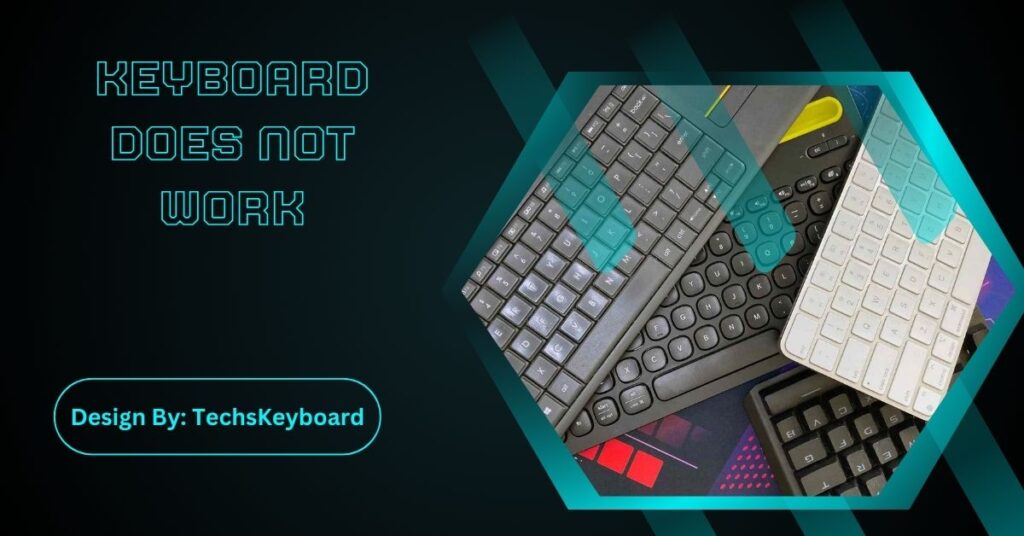Keyboard issues can stem from low battery, driver corruption, or physical damage. Solutions include restarting your device, updating drivers, checking USB ports, and inspecting for damage or faulty connections.
In today’s technology-driven world, our keyboards are indispensable tools for work, communication, and entertainment. However, encountering a non-responsive keyboard can be an incredibly frustrating experience. But before you panic or rush to purchase a new one, it’s essential to diagnose the root cause of the problem.
Why Has My Keyboard Stopped Working Suddenly?

Several factors could hinder the functionality of your keyboard, ranging from simple issues like a low battery to more complex problems like corrupted drivers.
Corrupted or Missing Drivers
Drivers act as a communication bridge between your keyboard and your operating system. If these drivers become corrupted or go missing due to software updates or malware, your keyboard might stop working efficiently.
Faulty Motherboard
Sometimes, the issue might not be with the keyboard itself but with the motherboard. A malfunctioning motherboard can result in hardware connectivity issues, including problems with your keyboard.
Accidental Damage
Everyday accidents such as spills or physical damage can prevent keyboards from working properly. Ensuring your keyboard is free from liquid damage and physical obstructions is vital.
Low Charge or Faulty Battery
For wireless keyboards, a low battery is often a common culprit. Similarly, if the battery is damaged or faulty, it may cause intermittent issues.
Wrong USB Port
If you’re using a wired keyboard, plugging it into a faulty USB port could be the problem. A simple switch to another port might solve the issue.
Device Updates
Right after a device update, some peripherals might malfunction because of compatibility issues. Ensuring all drivers and software are up-to-date can help alleviate this problem.
Power Saving Features
In efforts to conserve power, some systems will disable certain peripherals when they’re not in active use. This could inadvertently affect your keyboard’s performance.
Also Read: How To Restart PC With Keyboard – Troubleshooting Guide!
How Do I Fix My Keyboard Not Typing?
Now that we’ve discussed potential causes, let’s walk through some troubleshooting steps to get your keyboard functioning again.
1. Set Up the On-Screen Keyboard
Before trying any advanced solutions, enable your device’s on-screen keyboard. This can be a temporary workaround that allows you to continue working while diagnosing the issue.
- For Windows: Navigate to Settings > Ease of Access > Keyboard, then toggle the “On-Screen Keyboard” option.
- For Mac: Go to System Preferences > Keyboard and check “Show keyboard and emoji viewers in menu bar.”
2. Restart Your Device
A simple restart can resolve many hardware-related issues by refreshing the system’s resources and clearing out any temporary software glitches.
- Save your work and close all applications.
- Restart your computer or device.
- Test the keyboard again once the system has rebooted.
3. Turn Off Power Saving
Power-saving settings can sometimes affect keyboard performance, particularly for wireless models.
For Windows:
- Open Device Manager.
- Find your keyboard under “Keyboards.”
- Right-click and select “Properties.”
- Navigate to the “Power Management” tab and uncheck “Allow the computer to turn off this device to save power.”
For Mac:
- Open System Preferences.
- Go to Energy Saver and adjust the settings to prevent the system from powering down connected devices.
4. Update or Reinstall Drivers
If your keyboard drivers are outdated or corrupted, updating or reinstalling them can often resolve the issue.
Update Drivers:
- Open Device Manager.
- Locate your keyboard.
- Right-click and select “Update driver.”
- Follow on-screen instructions to search for updated drivers automatically.
Reinstall Drivers:
- Open Device Manager.
- Right-click on the keyboard and select “Uninstall device.”
- Restart your computer to allow the system to reinstall drivers automatically.
5. Check for Physical Damage
Run a thorough inspection of your keyboard for any visible signs of damage. Gently clean it using compressed air to remove any debris.
6. Test with Another Device
To determine whether the issue is with the keyboard, connect it to another device. If it works, the problem likely lies with your original device. If not, the keyboard may need replacement.
7. Use Different USB Ports
For wired keyboards, try plugging the keyboard into different USB ports on your computer. It might be a simple connectivity issue that can be resolved by changing ports.
8. Check Wireless Connections
For wireless keyboards, ensure that Bluetooth is turned on and functioning correctly. Re-sync the keyboard with your device to restore its connection.
Keyboard Not Working:
If your keyboard is not working, the issue could be hardware failure, driver conflicts, or a simple connection problem. First, check if it’s properly plugged in or if the wireless battery is charged. Restarting your computer might help, as well as updating or reinstalling drivers. If some keys work but others don’t, debris under the keys could be the cause. A quick clean or external keyboard test can diagnose the issue.
FAQs:
1. Why has my keyboard suddenly stopped working?
Possible reasons include corrupted or outdated drivers, power-saving settings, physical damage, faulty USB ports, or low battery. Diagnosing these can help identify whether it’s a software or hardware issue.
2. How can I fix an unresponsive keyboard?
Restart your device, update or reinstall keyboard drivers, and check power-saving settings. For wireless keyboards, ensure Bluetooth is functioning and batteries are charged. Try different USB ports for wired keyboards.
3. Can power-saving settings affect my keyboard?
Yes, some systems deactivate peripherals like keyboards to save power. Adjust settings in Device Manager (Windows) or Energy Saver (Mac) to prevent your keyboard from being affected.
4. What should I do if my keyboard only works intermittently?
Ensure the keyboard is clean and free of debris, check for battery issues (wireless), update drivers, and try different USB ports. Testing with another device helps identify hardware faults.
5. When should I consider replacing my keyboard?
If your keyboard still fails after testing it on multiple devices, updating drivers, and checking connections, it’s likely damaged and may need replacing to restore functionality.
Conclusion:
Keyboard malfunctions can disrupt productivity, but many issues have simple fixes. Restarting your device, updating drivers, and switching USB ports can resolve common problems. Regular inspections for physical damage and cleaning help maintain performance. If troubleshooting fails, testing with another device confirms if the issue lies in the keyboard or the computer. Persistent non-responsiveness may require professional assessment or replacement to ensure seamless operation.


